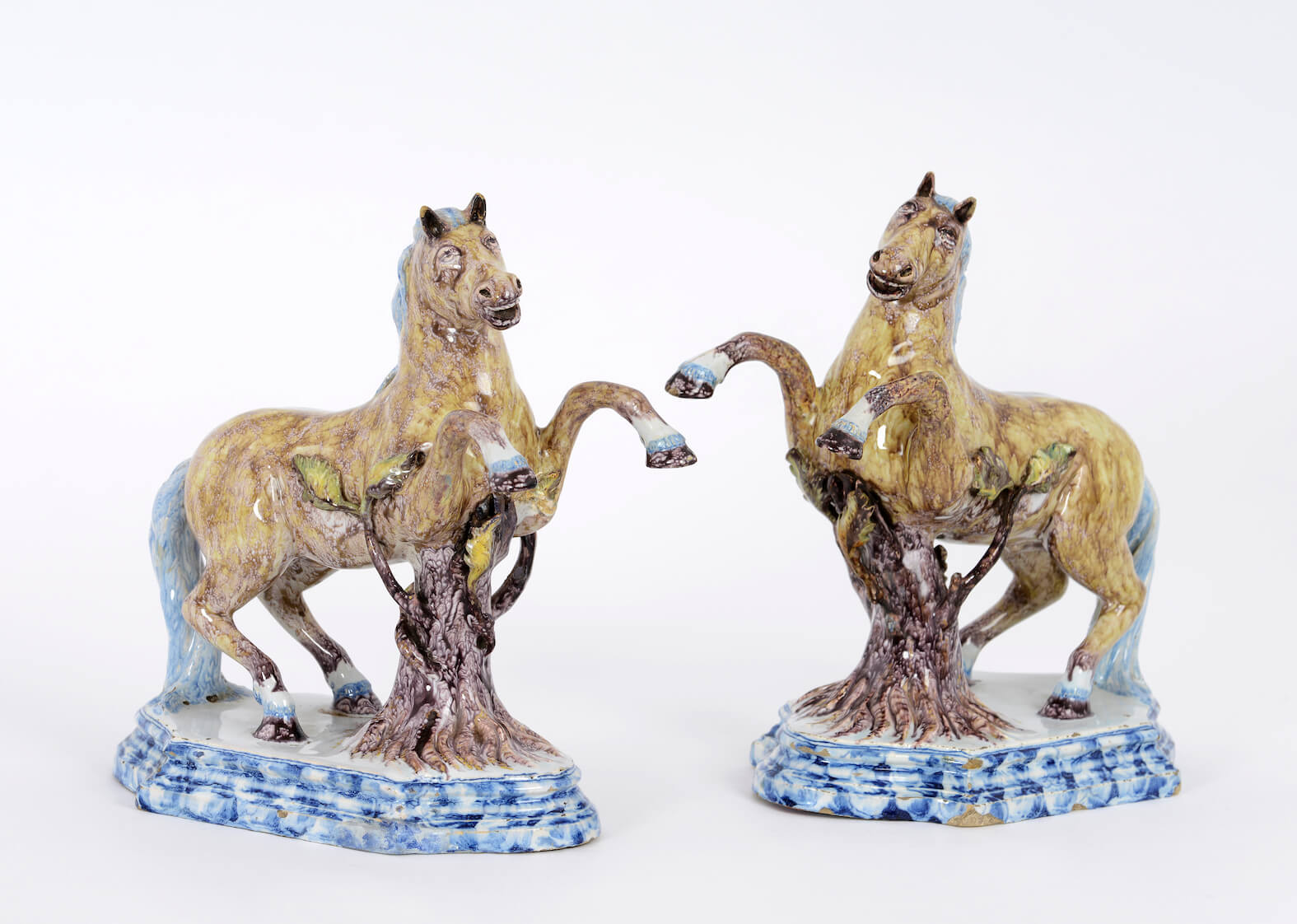
[popup_trigger id=”13756″ tag=”span”]![]() [/popup_trigger]
[/popup_trigger]
Images on this website are licensed under a
Creative Commons Attribution-NoDerivs 3.0 Unported License.

OBJECT
•D1966. Pair of Polychrome Models of Leaping Horses
Arnhem, circa 1765
Attributed to the factory of Johan van Kerckhoff, Arnhem
Each decorated in brown and yellow with light blue and manganese details, modeled affronté, rearing above a manganese tree stump issuing four green and yellow-leafed branches, the rounded rectangular base with a molded edge marbleized in blue.
Heights: 24 and 24.5 cm. (9.4 and 9.6 in.)
Provenance: Probably the collection of Clemens Fredericus Wilhelmus Baron Van der Heyden, heer van Doornenburg en Suideras (1791-1838) and hence by family descent, through 1932; Salomon Stodel Antiquités, Amsterdam, 1998 (then attributed to Delft); Dutch Private Collection NOTE The attribution of this unmarked pair of horses to Johan van Kerckhoff of Arnhem follows the research on a very similar blue and white pair set forth in Aronson 2004, pp. 148-149, no. 170. Very few examples of this model in tin-glazed earthenware, based on a late sixteenth-century bronze by Giovanni da Bologna (1529-1608), are known, and where illustrated and discussed, the literature is in disagreement. An example in the Wintergerst Collection, Esslingen, Germany, illustrated by Hans Erdner and Gert K. Nagel, Die Fayencefabrik zu Schrezheim, 1752-1865, Ellwangen/Jagst, 1972, ill. 38, and undoubtedly from the same mold, is attributed to Schrezheim by the authors, who also cite the pair illustrated in Aronson in 2004 as being in the Fischer-Böhler Collection, Munich. Another pair of the same models, illustrated in the XIIe Oude Kunst- en Antiekbeurs 1960 catalogue from the collection of the late Bernhard Stodel, is on loan in the collection of Museum Lambert van Meerten, which is currently displayed in Museum het Prinsenhof in Delft and ascribed both there and in the 1960 catalogue to Delft, though without a specific factory attribution. A further pair is illustrated in Aronson 2006, pp. 76-77, no. 56. The revision of the previous attributions is based not only on the physical characteristics of the horses: the quality of the modeling, the purity of the glaze, and the palette of the rather quirky decoration, but also on the fact that with Arnhem’s proximity to Germany, Johan van Kerckhoff is known to have employed German craftsmen, who worked in their native manner and fashion. While it would have been reassuring to find the cockerel mark of Arnhem on these horses, only a limited number of pieces bearing this mark are known, and no animal models are among them. Nevertheless, from an advertisement in the Amsterdamsche Dinsdagsche Courant of May 28th, 1765, it is evident that animals must have been manufactured in Arnhem, as Mr. Jan Bezoet on the Nieuwe Zijds Agterburgwal in Amsterdam announced that he is selling: “Alle zoorten van Arnhems Aardewerk, zo best als gemeen, na de Saxische, Fransche en Engelsche Trant, bestaande in Fontijnen, Tafel Serviesen, Beeltjes, Gevogelten, Vrugten, Terrines, Koffykannen, Thee Potten,…” (“All kinds of Arnhem faience, the best as well as the ordinary, in the Saxon, French and English styles, consisting of fountains, dinner services, figures, birds, fruits, tureens, coffee urns, teapots…”). Following the discovery of two more pairs of horses of these models, the Arnhem attribution was generally accepted and has been discussed more fully by Hans Ressing in “Een kleine veestapel, Dierfiguren uit de Arnhemse fabriek van Johan van Kerckhoff,” Vormen uit vuur, 193, 2005/4, pp. 31- 36. In this essay two single examples of this model are illustrated on pp. 31-32, pl. 1-3; p. 33, pl. 5 shows the aforementioned pair illustrated in Aronson 2004; and pl. 6 shows a fourth pair, which is in the collection of the Museen der Stadt Aschaffenburg, Schlossmuseum der Stadt im Schloss Johannisburg, Germany.
Sold
AVAILABILITY
Sold








